Looking for the best task management software for small businesses?
Trying to keep up with quarterly goals and deadlines can feel impossible without the right tools at your disposal. Task management software lets you see all of your team’s work in one place so you can prioritize what matters most and get more done.
In this article, we’ve handpicked the best task management software for small businesses to boost productivity, improve organization, and increase revenue.

What is Task Management Software and Why is It Important?
Staying on top of priorities is difficult, especially for small teams that often wear multiple hats. They juggle client interactions, content marketing, product development, administrative tasks, and more.
Without a systematic approach to task management, important assignments can slip through the cracks, leading to missed deadlines and dissatisfied customers.
That’s why you need task management software. It can be a centralized hub for work management and project planning. You will be able to track everything between project planning and completion.
Your task list will be allocated to the right people in a place designed for team collaboration. And best of all, your team will be prioritizing the important tasks rather than spending time on busy work that doesn’t produce results.
15 Best Task Management Software (Free and Paid)
At WPBeginner, our goal is to help small businesses compete with the big guys. With task management tools, your teams can work faster.
That’s why we’ve sifted through the clutter of endless task management solutions and only given the tools we believe are the very best.
Let’s dive in!
1. Asana

In our opinion, Asana is the best task management software for small businesses.
Asana doesn’t just help you manage tasks. It connects all the work your company is doing to high-level goals and business strategies while also breaking down complex projects into manageable tasks.
You can set key results and goals for your company, team, and individuals and see how they ladder up. Every task links to a goal, ensuring that nobody wastes time on low-priority tasks. There’s even reporting on your goals so you can track progress across your company.
Asana is customizable and flexible to your team’s needs. You can create automated workflows without any coding.
For example, every time a particular task passes a certain stage, you can automatically assign it to the next person in the flow or create recurring tasks so you never forget important activities. And, of course, you can view projects and tasks in many ways, including lists, kanban boards, timelines, calendars, portfolios, and workloads.
Their free version isn’t anything to scoff at, either. Many free plans for task management software are too restrictive and not functional for small businesses. But Asana doesn’t hold back.
Its free plan supports unlimited projects, messaging, file storage, messaging multiple project files, storage, and more. Plus, Asana has a mobile app for iOS and Android devices, so you can manage your to-do list on the go.
Pricing: With Asana’s free version, you get all the basic features you need, like unlimited tasks and projects. If you want access to their advanced features such as timeline, goal tracking, or approvals, look at their Premium or Business plan.
2. Monday.com
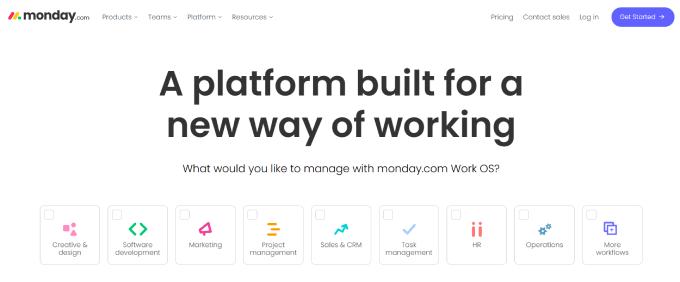
Monday.com is one of the most versatile and powerful task management software on the market. Trusted by over 180,000 businesses, it can handle just about anything, from basic task organization to resource management and a full project portfolio.
Establishing workflows from scratch can be time-consuming. But thanks to Monday.com’s customizable templates, you can skip the setup process. Choose from dozens of project templates for campaign planning, project portfolio tracking, product roadmaps, customer support tickets, onboarding, and more.
The dashboards are extremely customizable, with 30 pre-built widgets you can use, including a capacity planning widget that allows project managers to allocate resources to the right people.
And Monday.com makes it easy to break down big goals into manageable day-to-day tasks. You start by setting goals and objectives based on business priorities. Then, you can define the projects and processes needed to reach goals. From there, you’ll create parent/child tasks & subtasks that align with the project and goals.
Monday.com’s claim to fame is its built-in customer relationship management (CRM) app. You can easily organize your prospects by where they are in the pipeline.
The CRM is designed to keep everything organized and save you time. That’s why they have automation features that can set reminders for activities, automatically assign leads to reps, and edit deal stages.
For developers, Monday.com has a specific ‘Dev’ product that helps you launch, design, and iterate products. Their features backload, bug tracking, roadmap planning, and sprints help you address all product-related issues and ensure you leave no stone unturned.
If you own an online store, Monday.com has a WooCommerce integration. That means you can take advantage of their user-friendly interface to manage your online orders and inventory levels.
Pricing: The free plan gives you up to 3 Kanban boards and is great for individuals. To access the Gantt calendar or timeline view, you’ll need to upgrade to their Standard plan at $10 per month. Premium plans give you automation, time tracking, integrations, and a wide range of other features.
3. Kanban Boards for WordPress
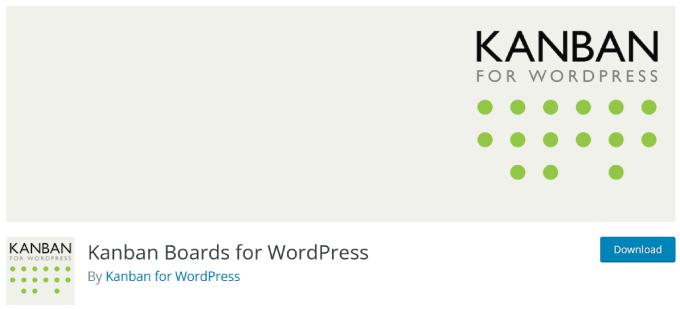
Kanban Boards for WordPress brings the popular project management methodology into your dashboard for free.
It’s perfect for businesses that want to manage simple to-do lists without feeling overwhelmed. These project boards are customizable, and you can edit them right from the interface.
You can create and assign tasks to team members with due dates and track how long it takes to finish them. With this plugin, you can even create custom views, which filter the board by different criteria.
But why use Kanban boards in WordPress in the first place instead of something like Asana or Monday.com?
Because publishing content consistently on your WordPress blog is vital for increasing traffic and converting visitors to customers. The Kanban boards will allow you to plan ahead and create highly customizable editorial calendars. That said, you may want to combine Kanban Boards for WordPress with other calendar-specific plugins since this tool doesn’t have a calendar view.
Adding this Trello-like kanban board in WordPress is super simple, too. All you have to do is install the plugin and configure a few settings. Then, start creating tasks and assigning them to your team.
Pricing: It’s free to use, with a paid version available for $149 per year.
4. ClickUp
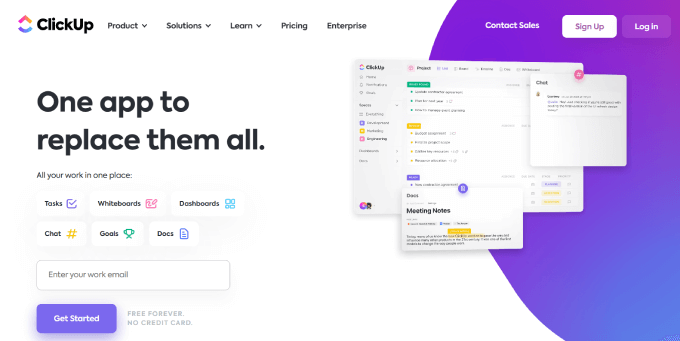
ClickUp is the do-everything task management platform since it has arguably more features than any other option on the list.
One of the major selling points is the ability to fully customize the tool based on your business model and workflow. For example, the custom fields feature lets you add all types of information to your views, while the custom dashboard gives you over 50 widgets to build your dashboards so you can see the metrics in your business that matter.
Also, Clickup makes it easy to manage your time with flexible time-tracking features. Even if you work remotely, time tracking is still useful. For example, users can track how much time it takes to complete tasks.
On the other hand, project managers can look at past timesheets to help them better allocate the right amount of total hours per project.
One of their latest new tools is ClickUp AI, a feature that brings artificial intelligence to just about all phases of planning. You can use AI to create project timelines, write project briefs, write emails, summarize meeting notes, create status reports, and more.
Pricing: If you’re a freelancer or individual, the free plan gives you 100MB of storage, kanban boards, and a calendar view. The Business plan at $12 per month is perfect for small businesses, providing unlimited storage, goals, portfolios, resource management, and more.
5. AirTable
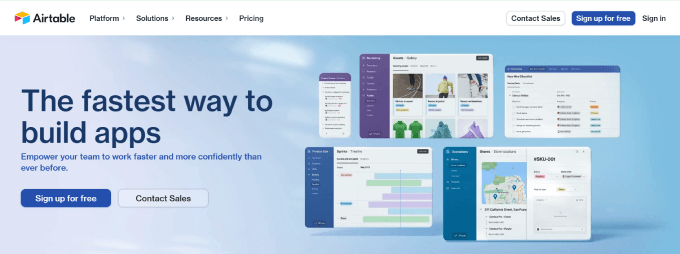
AirTable is a highly customizable cloud-based task management platform that allows you to build custom databases and applications from scratch. This lets you organize your data, processes, and workflows however you like. Compared to most other task management tools, Airtable is much more flexible.
That being said, starting from scratch isn’t for non-techy people. Fortunately, you can use their many templates for common use cases and then make changes to fit your company. Try one of their many templates within categories ranging from content production and software development to PR and real estate.
One of the best parts about AirTable is its seamless integrations with popular business tools, including WordPress. With over 43% of the internet using WordPress, it only makes sense that task management tools connect with it.
There are two ways to integrate with AirTable. One is through the platform’s built WordPress integration, and the other is the Uncanny Automator tool. Either way, you’ll get the exact AirTable interface right in your WordPress site.
Pricing: AirTable offers a free plan, which provides access to all types of views, 5 editors, and even automation features. Their paid plans offer more storage, editors, and premium features.
6. Teamwork
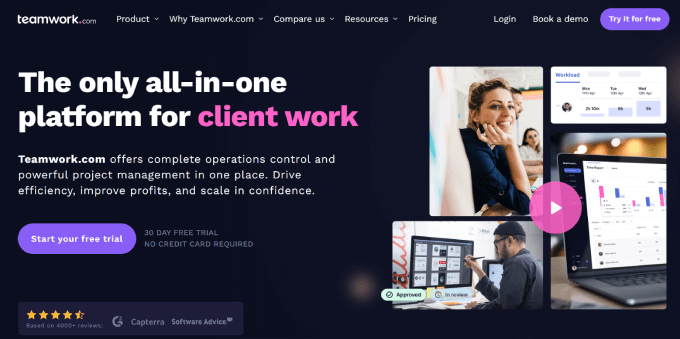
Next on the list is Teamwork, a task management tool best known for its collaboration features.
While Teamwork can handle many use cases, it really rises to the occasion when handling client work or managing creative teams. For example, you’ll find features like billable time tracking, custom branding, invoicing, intake forms, and client and collaborator access to help manage projects seamlessly.
That said, we recommend using a separate, more robust form builder like WPForms when creating any client forms or questionnaires.
You can also empower clients by giving them partial access to Teamwork so they can add comments and see your task list.
Teamwork connects with popular tools you already use, like Google Drive, Dropbox, Quickbooks, and more. This means you don’t have to go to separate platforms to find the files or data you’re looking for.
Most task management software offers a free plan for individuals. But Teamwork provides more features in its free tier than most of its competitors. You get access to 5 users with premium features like automation, team availability, Gannt chart views, time tracking, and milestones, all of which are rare to find on a free plan.
Pricing: Teamwork gives you everything you need to get started with their free plan. You get up to 5 users, all the project views, and even access to task dependencies.
7. Smartsheet
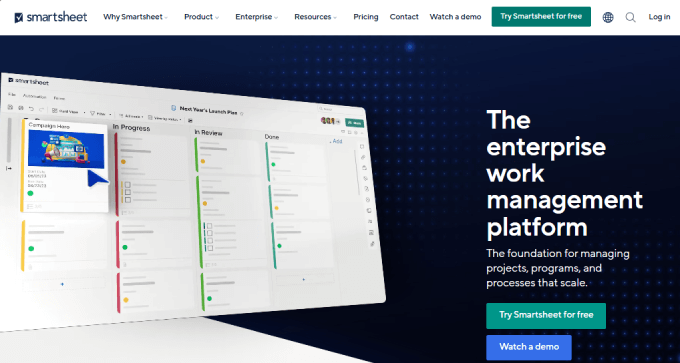
Smartsheet is a web-based solution that lets companies of all sizes with task management, crowdsourcing, reporting, and more.
Think of Smartsheet as a more advanced version of Excel spreadsheets. This system can feel more familiar for companies who are comfortable using spreadsheets for project management.
That’s because you can add formulas and functions to perform calculations or manipulate data. It’s particularly useful when you need to pull data from different sheets or make calculations. For example, you track sales team revenue or make financial projections based on the team’s current pace of work.
What makes Smartsheet stand out is its advanced reporting capabilities. You can easily pull together the most important information from multiple sheets into a single report with just a few clicks. In doing so, you’ll spot trends and potential bottlenecks to help your team continuously improve.
There are also many ways to use Smartsheet. Much like a spreadsheet, you can manipulate your sheets into almost anything from task management, budget tracking, inventory management, campaign tracking, expense categorization, and more. You can use this tool in hundreds of different ways, making it a contender to replace other business tools you might already use for other functions.
That said, it’s not as easy to use as some of the more popular task management software and doesn’t have the familiar Kanban boards we’ve all come to love.
Pricing: Smartsheet offers a free plan with access to all the basic features. The Business plan costs $25 per user per month and is great for small businesses that want to manage projects with unlimited editors.
8. Trello
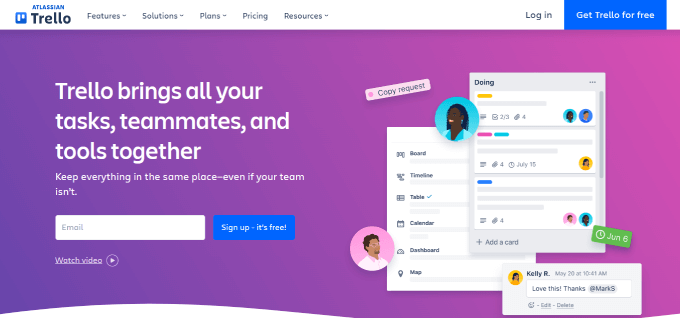
Trello is a simple task management tool best known for its Kanban-style boards.
Their customizable interface lets users set up cards on different boards like they are post-it notes.
Within each card, you can assign tasks to team members, add comments, share files, tag users, and create checklists. Trello is highly customizable, allowing you to label cards so you can easily identify them.
The drag-and-drop feature is convenient. Simply slide the cards from one column to the next as they hit various milestones. For assignees, it’s probably the easiest platform to use since everything is done through the Kanban board.
It’s worth mentioning the Power-Up feature, where you can add integrations and features to your boards. This includes document management, calendar view, time-tracking, social media, and custom fields.
Trello is great for small teams and individuals since it’s super easy to use. However, it lacks advanced functionality for businesses with multiple teams since it lacks built-in dependency management and a Gannt chart to display a project’s timeline and milestones.
Pricing: Trello is free to use with unlimited cards and up to 10 boards per workspace. Upgrade to the Premium plan at $10 per user per month for the calendar, timeline, table, and map views.
9. PublishPress
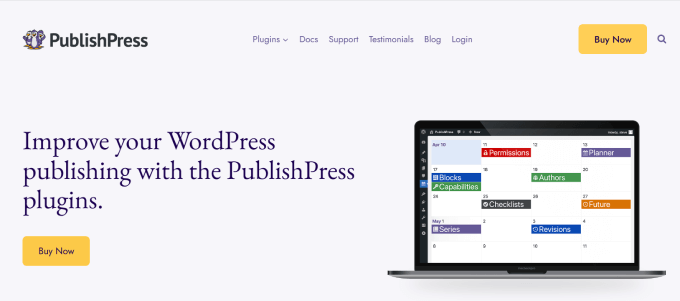
PublishPress is an entire suite of plugins, all focused on helping you manage editorial calendars. If you want to start a WordPress blog or already have an active one, PublishPress Editorial Calendar is the plugin for you.
The hallmark of a successful blog that drives traffic is consistency. Getting on a consistent schedule and planning your content in advance will help you output enough blog posts. Also, make sure to use a keyword generator tool to help you plan and create the right type of content that attracts your desired audience.
All the content ties directly to the blog post on your WordPress site. Through the calendar view, you’ll see when each post will be published.
WordPress only provides a few status options like ‘Draft’ or ‘Published.’ With the PublishPress Permissions plugin, you can customize your workflow to fit your editorial process. Additional statuses like ‘Pending Review’ or ‘Edits’ could be useful to let everyone know what stage each blog post is in.
Pricing: It’s free to use all of PublishPress plugins. All you need to do is install and activate them directly from the WordPress plugin repository. However, if you want more advanced features, you can upgrade to PublishPress Pro and get access to the premium version of each plugin. Plans start at $129 per year.
10. Jira Software

Jira Software is designed with developers in mind. It’s one of the many tools from Atlassian to help agile teams get things done. By agile teams, we mean groups that work collaboratively and cross-functionally. This often entails breaking projects into smaller tasks assigned to different people.
Think of Jira Software as a tool to track everything that happens across iterations. You can identify roadblocks as quickly as possible, focus on constant improvement, and hit your objectives with as little drama as possible.
You’ll get cards pre-set for Scrum and Kanban and more than a dozen Agile reporting tools. While they aren’t stunningly beautiful reports, they’re great for progress tracking.
For example, you can create a backlog, which lists all the work items that need to be addressed in the project. Then, create a sprint to commit to solving these issues during a specific time frame.
It’s great for larger teams, especially for teams of designers and developers. However, Jira Software tends to be harder to learn as it includes numerous advanced features and complex terminology.
Pricing: Jira Software lets you get started for free and gives access to up to 10 users. Higher-tiered plans provide more storage and user roles and permissions. In the free plan, every user is a project admin.
11. ProofHub
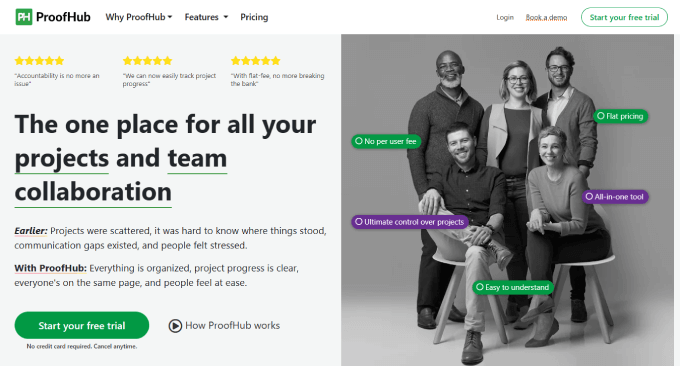
ProofHub is an all-in-one task management app recommended by many Fortune 500s and trusted by over 85,000 teams worldwide.
The software is best known for its extensive collaboration tools. They make it simple to communicate with your team to execute projects quickly. With one-on-one group chat boxes and discussion boards, you can collaborate with team members without the back-and-forth long email or Slack threads.
You can view all updates about a topic in one place and easily understand where the project is going. Also, project admins can make announcements, similar to social media posts. This lets you celebrate achievements, share updates across teams, and confirm priority changes.
ProofHub also has a wide range of features to let your team collaborate on creative assets. You markup your visual and text files to provide pinpoint feedback on where and what needs addressing.
There’s a variety of project views to fit your use case, such as board, Gannt charts, calendar, and table view.
Pricing: Starting at $45 per month, the Essential Plan offers all the core features to run your small business effectively. That includes project management, boards, Gantt charts, time tracking, file approvals, and chat.
12. Hive
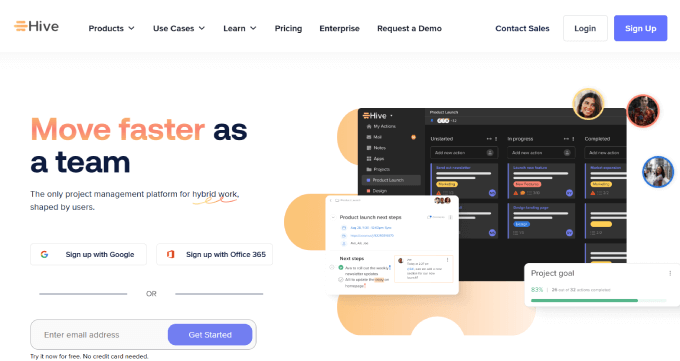
Hive is an all-encompassing solution that does more than just manage tasks. For example, the software boasts a unique email integration allowing users to send messages from Gmail and Outlook to Hive.
There are also real-time collaboration features like a video chat function, a note-taking app (similar to Google Docs), and an intake form builder. You can even use their AI tools to write content, craft email responses, and create project tasks based on suggestions.
As for the task management itself, Hive lets you manage your projects in one of nine project views, including Gantt charts, kanban, and more. They’ve made it super easy to visualize anything you want to see. Plus, you can color code tasks or customize notifications so you stay on top of key action items.
There’s even built-in automation, allowing you to automate routine tasks. For example, you can set up a trigger and action, such as every time a certain task is completed, the system will send an email or update a row in Google Sheets.
Hive is perfect for just about any creative or business operation team that wants to streamline or automate certain workflows.
Pricing: Hive is free to start but only gives access to two users. If you want to manage a small team, go with the Team plan at $12 per user per month. You get all the task views, time tracking, and 7 custom addons to expand your Hive functionality.
13. HubSpot Task Management
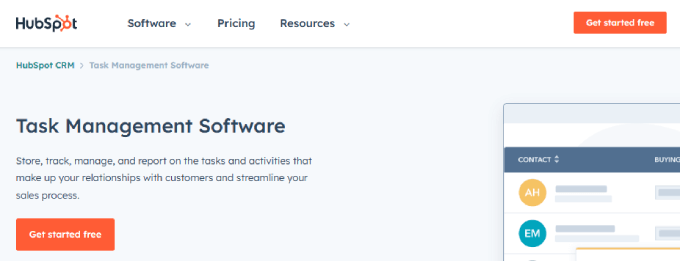
While HubSpot Task Management isn’t a traditional task management solution, its CRM platform has task and project management capabilities.
If you’re a salesperson, then you may consider HubSpot because of their email marketing, CRM, chat, and, of course, task management tools, all natively connected in one. This is important because you can easily connect your tasks with contacts, giving you more insight into your leads.
As a user, you can create workflows to schedule new tasks, set up reminders, and compare your performance to past data. Having your task list organized with filter options can prevent you from wasting time on administrative tasks that don’t generate revenue.
However, it doesn’t include a kanban board or calendar view, nor does it allow for dependencies, making it less useful for project managers and other departments outside of sales.
Pricing: HubSpot Task Management is completely free to use. If you want to integrate your tasks with contacts, calls, or other marketing and sales activities, check out the complete HubSpot pricing plan, which includes their entire suite of products.
14. Wrike
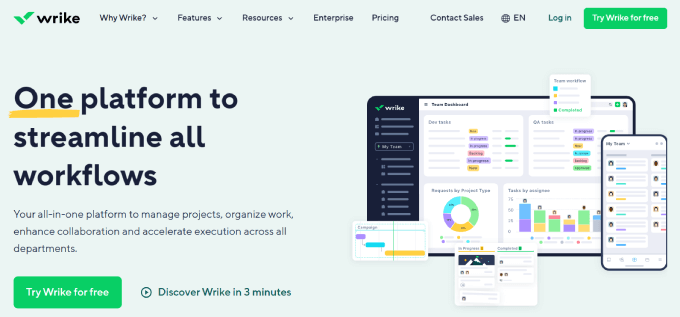
Wrike is a comprehensive project management tool tailored to agencies, marketing teams, and professional service providers.
Like many of the top platforms, you can assign tasks, add dependencies, and view the progress of projects all in one place. You can also see projects using Gannt charts, kanban boards, tables, and lists.
Wrike has direct integrations with many of the popular business apps, meaning you won’t have trouble pulling information from your email, CRM, or other software. In other words, you’ll have highly detailed reports since you can connect data from across your organization.
The downside of Wrike is its high costs. As a small business, you’ll need to at least subscribe to their team plan at $9.80 per user per month. Even this plan is missing reporting features and user permission. In this case, you’ll need to upgrade to their Business tier at $24.80 per user per month.
Pricing: Wrike is free to start but only gives you the board and table view. The Team plan at $9.80 per user per month provides access for up to 25 users, unlimited views, and even an AI content generation tool.
15. Atarim
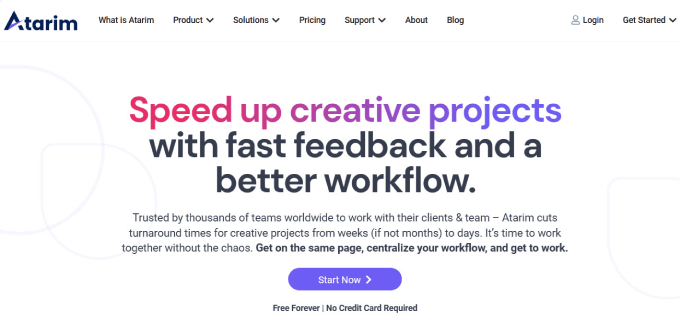
Atarim is an up-and-coming task and project management tool best used for web design agencies. Since it has a WordPress plugin, you can easily install Atarim to your client’s WordPress website.
Essentially, Atarim offers a powerful visual collaboration tool where you can make comments on any part of a client’s website, similar to how you would with Google Docs. You can tag internal team members and link it to a task that directly sends you to a Kanban board.
Or you can notify clients so you can pinpoint exactly what you plan on changing. This eliminates back-and-forth emails, so you can quickly show them which area of the website you’re working on.
They even have everything you need to manage projects for a web design agency, such as the ability to create client intake forms and time tracking for freelancers. That way, you can keep all of your tasks in one place, and you don’t need to switch between different tools.
Pricing: Free plans are available for one user. Paid plans start at $20 for access to 5 users and 20 projects. (Note: this essentially means 20 websites.) Higher plans give you access to more collaborators and projects to work on.
Our Pick: Best Task Management Software
To maximize your team’s productivity and hit your biggest goals for the year, you need the right business tools to grow your small business.
So which one is right for you?
Asana is hands down the best task management software for small businesses. It connects all of your tasks directly to your goals, ensuring your team spends time on meaningful work. It’s affordable and lets you create customized workflows and automation. This automates repetitive work and frees up your time for more big-picture projects.
If you publish content regularly, Kanban Boards for WordPress is the best choice. It’s super easy to use since you simply drag and drop cards across the board as they move stages.
Smartsheet is for spreadsheet lovers who love the grid interface or want to use formulas to make calculations. This is great for sales teams who want to track sales or make financial projections.
Jira Software is the go-to platform for developers and designers. Features like backlogs, bug tracking, roadmaps, and dependencies help teams go from ideation to launch.
We hope this article helps you determine the best task management software for your small business. You might also want to read our guide on the best WordPress plugins for business websites or best live chat software for small businesses.
If you liked this article, then please subscribe to our YouTube Channel for WordPress video tutorials. You can also find us on Twitter and Facebook.
The post 15 Best Task Management Software for Small Businesses first appeared on WPBeginner.
